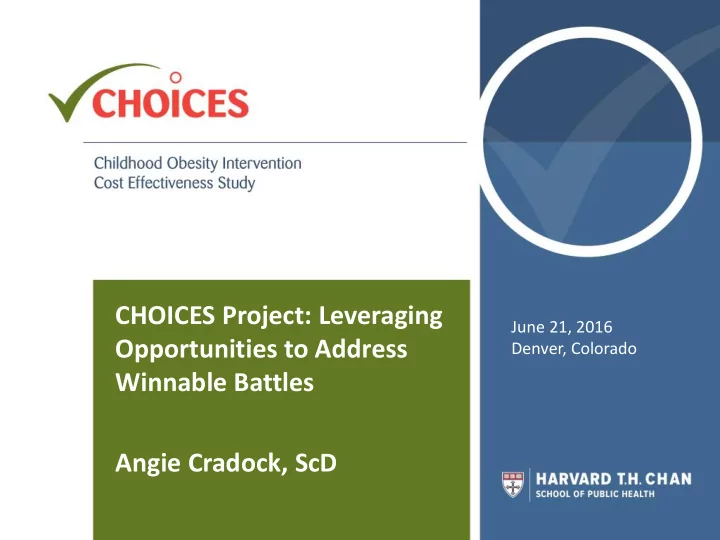

CHOICES Project: Leveraging June 21, 2016 Opportunities to Address Denver, Colorado Winnable Battles Angie Cradock, ScD
CHOICES- Why are we doing this? Childhood obesity Best results Public policy, prevention for dollars public health, policies and invested general public programs
Cost Effectiveness Analysis Cost Effectiveness Analysis compares the costs and outcomes of: vs. vs. One policy or Two policy or OR program intervention program with no intervention interventions
Costs & Outcomes + Higher costs Higher costs Difference in Cost Worse outcome Better outcome – + Lower costs Lower costs Worse outcome Better outcome – Difference in Effectiveness
Costs & Outcomes + Higher costs Higher costs Difference in Cost Worse outcome Better outcome – + Lower costs Lower costs Worse outcome Better outcome – Difference in Effectiveness
How Can CHOICES Methods/Results Help You? Provide evidence for action Explain impact on population Uncover effective implementation strategies Guide resource investment Cultivate alliances and support
Opportunity to Partner w/CHOICES CHOICES partnership work in year 2 States Large cities Large counties
Overview of CHOICES
CHOICES Model Outcomes Reach Effect Cost Who will benefit? How much will How much will a they benefit? program/policy change cost and will healthcare savings be more than implementation costs? Focus on obesity-related initiatives
Who will benefit? o Who? o How many? o Criteria to narrow description and number?
How much will they benefit? o How much will the intervention reduce BMI? o Peer-reviewed articles/evidence
Cost to make change? o Activities and resources to achieve effect o All costs regardless of payer o Value for all necessary resources o Not intervention participants’ time
Population - CHOICES Model Virtual population = 1 million people Matches state population o Accounts for personal characteristics o like dietary intake, body growth, and behaviors like smoking
Ten-Year Trends - CHOICES Model From 2015-2025, no intervention vs. intervention: 2015 2025 How many Differences in Healthcare people BMI changes? cost savings? benefit?
How the Model Works BASELINE SCENARIO Start: 2015 Simulate to: 2025 VIRTUAL POPULATION INDIVIDUAL POPULATION FACTORS FACTORS HEALTH STATUS OUTCOMES Population Body Growth Obesity Obesity Growth Personal Healthcare From 2010 U.S. Characteristics Costs BMI Trends Census Data (e.g. dietary intake) Mortality Smoking
How the Model Works INTERVENTION SCENARIO INTERVENTION SCENARIO Start: 2015 Simulate to: 2025 Dietary Intake/Physical Activity VIRTUAL POPULATION INDIVIDUAL HEALTH POPULATION FACTORS FACTORS STATUS OUTCOMES INTERVENTION Population Body Growth Obesity Obesity Growth Personal Healthcare From 2010 U.S. Characteristics Costs BMI Trends Census Data (e.g. dietary intake) Mortality Smoking
Interventions That Reduce Childhood Obesity CASES OF CHILDHOOD NET COST SAVINGS AFTER 10 YEARS OBESITY PREVENTED IN 2025 575,936 SSB Tax $14.17 billion Smart 344,649 $792 million Snacks 129,061 TV Ads $260 million NET COST AFTER 10 YEARS School $6.44 billion 1,815,966 Meals* Early $731 million 38,385 Childcare Bariatric Not applicable $303 million Surgery *The 95% uncertainty interval for the estimate includes zero (Gortmaker et al., Health Affairs, Nov. 2015.)
CHOICES State Partnership + o ASTHO connects states and other partner organizations to work with CHOICES team o ASTHO advised on framework and logistics for the state learning community partnership
CHOICES State Partnership Partner w/ state health agencies to: Identify and assess 2-3 interventions Apply state-specific implementation scenarios Communicate results to inform decision making
State Models Input state-specific data for cost-effective analysis State-specific intervention profiles Who will benefit? How much will How much does they benefit? it cost to make a program change?
States Use of CHOICES Model Washington Mississippi Example: Active Example: Early Care Recess Program and Education Screen Time Policy and Programs
More Info on Year 2 Partnerships Application process: o Application materials on http://choicesproject.org/work-with-us/ o FAQ webinar July 14 th 12 pm EST o Proposals due Aug 5 th o Awardees notified Aug 31 st Project year: Oct 1, 2016 - Sept 30, 2017 Includes financial assistance to health agencies to complete work For additional information: www.choicesproject.org, cgiles@hsph.harvard.edu
Recommend
More recommend